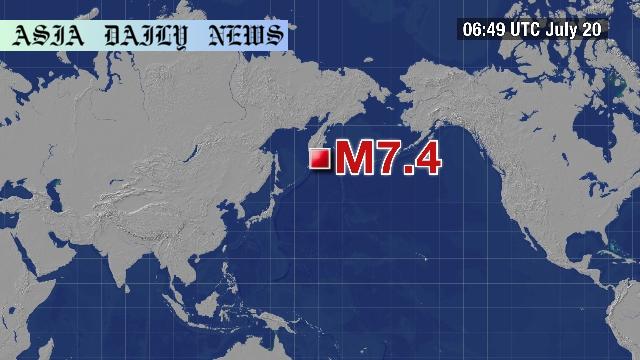Earthquake: A magnitude 7.4 earthquake struck off Russia’s Kamchatka Peninsula at a depth of 20 km, sparking tsunami warnings.

A Seismic Event of Magnitude 7.4
The United States Geological Survey (USGS) has reported a significant earthquake measuring 7.4 in magnitude. The quake struck off the coast of Russia’s Kamchatka Peninsula at approximately 6:49 a.m. UTC on Sunday, marking a critical tectonic event in this highly seismic region. With a depth of 20 kilometers, the earthquake’s force emphasized the vulnerability of plate boundaries in the Pacific Ring of Fire, a known hotspot for tectonic activity.
Impact and Forecasted Tsunami Activity
Following the earthquake, the Pacific Tsunami Warning Center in Hawaii issued an alert for potential tsunami waves. Waves between 0.3 meters and 1 meter above tide level are projected for areas along Russia’s coastline. Additionally, smaller waves of less than 0.3 meters are expected to reach Hawaii, the northwestern Hawaiian Islands, Midway Island, and parts of Japan. Although these waves may seem minor, their impact can vary based on local coastal structures and conditions, necessitating vigilance.
The Geopolitical Importance of the Kamchatka Peninsula
The Kamchatka Peninsula is renowned for its active volcanoes, breathtaking landscapes, and its status as a UNESCO World Heritage site. However, being nestled within the Pacific Ring of Fire also makes it a hotspot for seismic activities. The latest earthquake underscores the perpetual geological challenges in the region, including risk preparedness for both residents and the global community that monitors tectonic developments.
Preparing for Tsunami and Broader Implications
While initial reports suggest limited tsunami threats to neighboring regions such as Japan and Hawaii, the potential for even modest waves underlines the necessity of early warning systems. These systems, managed by groups like the Pacific Tsunami Warning Center, have become critical in mitigating risks to lives and property. Advances in geoscience and satellite tracking continuously enhance preparedness, helping affected communities respond swiftly and effectively.
A Grateful Reminder for Robust Disaster Response Systems
This earthquake serves as a reminder of the critical importance of robust disaster readiness protocols. Countries in seismic regions must ensure their infrastructure, communication frameworks, and emergency procedures are equipped to handle earthquakes and potential aftershocks. As the global community increasingly cooperates through technological innovations, collective preparedness becomes a shared responsibility, particularly in the face of natural disasters.
Assessing the Future of Tectonic Activity in the Region
While the immediate concern lies within this particular seismic event, it is necessary to assess its future implications. Recurring seismic activity on the Kamchatka Peninsula could indicate broader tectonic movements across the Pacific Rim. Continuous monitoring by geological experts and institutions like the USGS is imperative to study fault lines and predict future occurrences. By understanding the tectonic underpinnings, communities can better prepare to mitigate adverse outcomes, ultimately saving lives and reducing infrastructure damage.
Commentary
An Unsettling Reminder of Nature’s Power
Earthquakes like the one that struck near Russia’s Kamchatka Peninsula serve as stark reminders of nature’s unpredictable strength. With a magnitude of 7.4, this seismic event stirred global attention due to its sheer intensity and the potential for devastating tsunami waves. Events like these highlight the importance of ongoing research and preparedness in seismically active regions.
The Role of Early Warning Systems
The swift response from the Pacific Tsunami Warning Center underscores the importance of early detection and communication. Alerting residents of the possibility of tsunami waves, even minor ones, can make the difference between life and death. This system highlights how technological advancements can help mitigate the adverse impacts of natural disasters, though challenges remain in ensuring everyone in affected zones receives timely warnings.
Global Cooperation for Seismic Preparedness
This earthquake also emphasizes the interconnectedness of nations in the Pacific. While the epicenter was located near Russia, its effects rippled enough to warrant warnings for Hawaii, Japan, and other areas. This underscores the global nature of seismic activity and the importance of collaborative disaster risk reduction strategies to ensure the safety of as many lives as possible.
A Call for Greater Awareness
Lastly, this event serves as a call to action for educating communities about earthquake and tsunami preparedness. From developing early warning systems to improving infrastructure resilience, proactive measures can significantly reduce the risks associated with natural disasters. The Kamchatka earthquake reminds us just how critical these efforts are to safeguard against loss and ensure recovery after such events.


